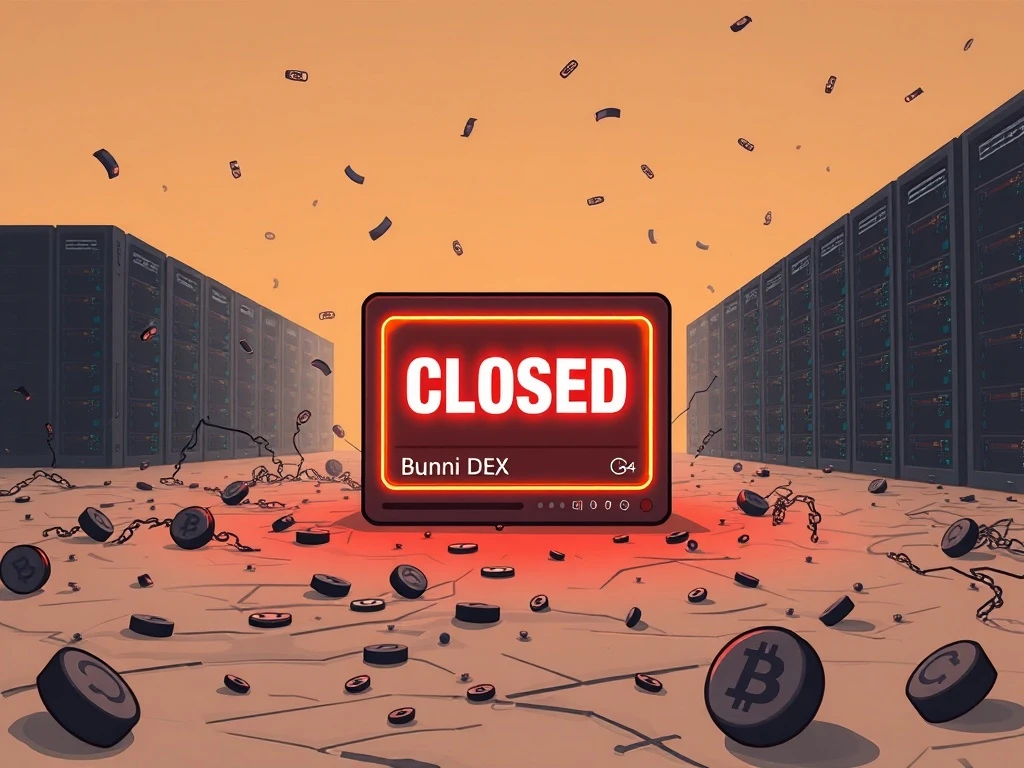Bunni DEX’s Tragic Collapse: Another Crypto Project Shuts Down This Week

The cryptocurrency market, known for its rapid innovations and inherent volatility, recently witnessed another unfortunate turn of events. **Bunni DEX**, a decentralized exchange that once showed immense promise, has announced its complete shutdown. This development follows an $8.4 million exploit in September. Consequently, Bunni DEX becomes the second significant **crypto project shutdown** this week, signaling challenging times for the broader digital asset ecosystem. Investors and developers alike are closely watching these developments, considering their implications for future **blockchain security** and project viability.
Bunni DEX’s Demise: An $8.4 Million DeFi Exploit
Bunni DEX confirmed its decision to cease operations in a recent X post. The team cited a critical lack of funds as the primary reason for this drastic step. Furthermore, the protocol suffered a substantial $8.4 million exploit on September 2. This incident significantly impacted its operations across Ethereum and the Layer-2 network Unichain. Operations immediately halted after the attack. The malicious actors specifically targeted the protocol’s codebase, according to a September 4 blog post by Bunni. This **DeFi exploit** proved a fatal blow to the promising platform.
Prior to the exploit, Bunni DEX was experiencing exponential growth. Its Total Value Locked (TVL) skyrocketed from $2.23 million on June 10 to nearly $80 million by August 19, as reported by DefiLlama. Bunni DEX was built on Uniswap V4. It aimed to optimize returns for liquidity providers. The platform achieved this through its custom mechanism, the Liquidity Distribution Function. However, the security breach eroded investor confidence and halted all progress.
Financial Hurdles and the Road to a Crypto Project Shutdown
The team revealed the severe financial strain imposed by the exploit. They stated, “The recent exploit has forced Bunni’s growth to a halt.” To securely relaunch the protocol, Bunni would require substantial capital. Specifically, audit and monitoring expenses alone would cost six to seven figures. Regrettably, the team simply did not possess these necessary funds. They acknowledged the considerable amount needed for development and other expenditures to restore the protocol. However, these funds were unavailable. Thus, the lack of capital directly led to the unfortunate **crypto project shutdown**.
This situation highlights a critical vulnerability in the DeFi space. Even innovative projects can collapse without adequate financial reserves for recovery post-attack. The incident underscores the ongoing need for robust funding models and comprehensive insurance solutions within the decentralized finance sector. Projects must prioritize sustainable financial planning alongside technological advancements.
Open-Sourcing for Future Innovation and Blockchain Security
Despite its closure, the Bunni DEX team took a commendable step. They relicensed Bunni V2 smart contracts from Business Source License to the MIT license. The MIT license is an open-source software license. This decision garnered significant praise from the wider developer community. Essentially, this move allows any developer to freely use all features and innovations developed by Bunni. These include key functionalities like Liquidity Distribution Functions, surge fees, and autonomous rebalancing mechanisms. This open-sourcing effort preserves Bunni’s technological contributions, potentially benefiting future DeFi projects.
Furthermore, the team assured users they can withdraw their assets via the website until further notice. The remaining treasury assets will also be distributed to BUNNI, LIT, and veBUNNI token holders. This distribution will occur after receiving necessary legal approval. Notably, team members will not receive any funds from this process. The team also pledged continued cooperation with law enforcement agencies. Their goal remains to recover the $8.4 million stolen by malicious actors, emphasizing their commitment to justice even in closure.
Kadena Exit: A Parallel Story of Market Conditions
Bunni DEX’s closure followed closely on the heels of another significant announcement. Just days prior, the founding team behind the Layer-1 blockchain **Kadena** also declared its winding down of operations. This announcement occurred on Tuesday. The Kadena team cited difficult market conditions as the primary reason for their departure. This situation presents a stark parallel to Bunni’s struggles, albeit for different immediate causes. Both events underscore the harsh realities of the current crypto market.
Despite the founding team stepping down, the Kadena network itself will continue to exist. It will transition to a community-driven model. However, the market reacted negatively to the news. Kadena’s native token, KDA, crashed 70% since the announcement. It currently trades for $0.06, according to CoinGecko. This highlights the profound impact that team stability and market sentiment have on a project’s perceived value and future prospects. The **Kadena exit** serves as a potent reminder of the fragility within the industry.
Broader Implications for the Crypto Ecosystem and Blockchain Security
The recent shutdowns of Bunni DEX and the Kadena founding team raise critical questions. These events prompt a closer examination of project sustainability and **blockchain security** in the decentralized space. The $8.4 million **DeFi exploit** on Bunni DEX serves as a potent reminder of persistent security vulnerabilities. Projects must implement rigorous auditing and continuous monitoring. Furthermore, the market conditions cited by Kadena indicate a challenging fundraising environment. This affects even established Layer-1 protocols. Both scenarios underscore the imperative for projects to build robust security frameworks and adaptable business models.
The crypto community must learn from these experiences. Enhanced security measures, transparent communication, and community governance are more crucial than ever. Investors, therefore, should conduct thorough due diligence. They must assess not only a project’s technology but also its financial resilience and security protocols. Ultimately, these events reinforce the need for constant vigilance and innovation. The goal is to build a more secure and sustainable decentralized future.







